
The London Borough of Redbridge is a London borough established in 1965.

Thomas John Barnardo was an Irish-born philanthropist and founder and director of homes for poor and deprived children. From the foundation of the first Barnardo's home in 1867 to the date of Barnardo's death, nearly 60,000 children had been taken in.
Albert Toft was a British sculptor.

Barnardo's is a British charity founded by Thomas John Barnardo in 1866, to care for vulnerable children. As of 2013, it raised and spent around £200 million each year running around 900 local services, aimed at helping these same groups. It is the UK's largest children's charity, in terms of charitable expenditure. Its headquarters are in Barkingside in the London Borough of Redbridge.
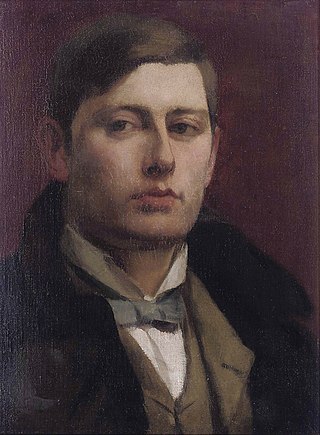
Sir George James Frampton, was a British sculptor. He was a leading member of the New Sculpture movement in his early career when he created sculptures with elements of Art Nouveau and Symbolism, often combining different materials such as marble and bronze in a single piece. While his later works were more traditional in style, Frampton had a prolific career in which he created many notable public monuments, including several statues of Queen Victoria and later, after World War I, a number of war memorials. These included the Edith Cavell Memorial in London, which, along with the Peter Pan statue in Kensington Gardens are possibly Frampton's best known works.
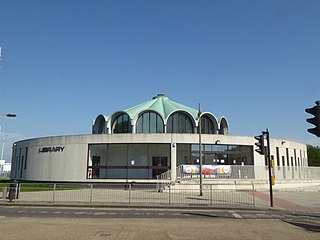
Barkingside is an area in Ilford, in the London Borough of Redbridge. It includes the major road junction of Fullwell Cross which also gives its name to the locality near that roundabout. The area is situated 10.6 miles (17km) north east of Charing Cross.
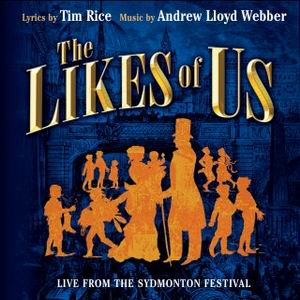
The Likes of Us is musical with music by Andrew Lloyd Webber, lyrics by Tim Rice, and a book by Leslie Thomas. It is based on the story of Thomas John Barnardo, a philanthropist who founded homes for destitute children.
Edward Alfred Briscoe Drury was a British architectural sculptor and artist active in the New Sculpture movement. During a long career Drury created a great number of decorative figures such as busts and statuettes plus larger monuments, war memorials, statues of royalty and architectural pieces. During the opening years of the 20th-century he was among the foremost architectural sculptors active in Britain and in that period created the series of works in central London for which he is perhaps now best known. These include the figures on the Old War Office building in Whitehall, elements of the facade of the Victoria and Albert Museum and four of the colossal statues on Vauxhall Bridge.
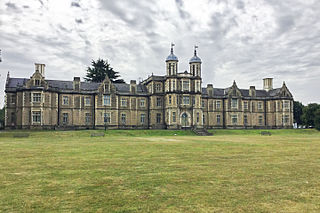

The Anti–Air War Memorial is located in Woodford Green, London, England. It was commissioned and erected by the socialist suffragist Sylvia Pankhurst in 1935 as "a protest against war in the air". It is Britain's first anti-war memorial, and is recorded in the National Heritage List for England as a Grade II listed building.

The Equestrian statue of Ferdinand Foch stands in Lower Grosvenor Gardens, London. The sculptor was Georges Malissard and the statue is a replica of another raised in Cassel, France. Foch, appointed Supreme Commander of the Allied Forces on the Western Front in the Spring of 1918, was widely seen as the architect of Germany's ultimate defeat and surrender in November 1918. Among many other honours, he was made an honorary Field marshal in the British Army, the only French military commander to receive such a distinction. Following Foch's death in March 1929, a campaign was launched to erect a statue in London in his memory. The Foch Memorial Committee chose Malissard as the sculptor, who produced a replica of his 1928 statue of Foch at Cassel. The statue was unveiled by the Prince of Wales on 5 June 1930. Designated a Grade II listed structure in 1958, the statue's status was raised to Grade II* in 2016.
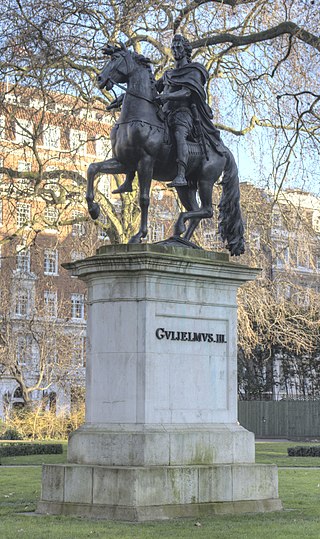
The equestrian statue of William III by John Bacon Junior stands in St James's Square in central London. It is modelled on an earlier statue of the king by John Michael Rysbrack in Queen Square, Bristol. Funding for the London statue was provided in the will of Samuel Travers, M.P., dated 1724, but nothing was done to progress the plan for a further seventy years. A design for the monument was drawn up in 1794 by Bacon's father, John Bacon Senior, but this was not executed and the commission passed to Bacon Jr., under whose direction the statue was finally erected in 1808. The statue is a Grade I listed structure.

The Gorilla sculpture by David Wynne stands beside the Lower Lake in Crystal Palace Park, in Bromley in south-east London. Completed in 1961 and installed in 1962, the black marble sculpture depicts Guy the Gorilla, a western lowland gorilla brought from West Africa to London Zoo in 1947. It became a Grade II listed structure in 2016.

The Memorial to Arthur Sullivan by William Goscombe John stands in Victoria Embankment Gardens in the centre of London. It was designated a Grade II listed structure in 1958.

The Gladstone Memorial on the Strand, London is a bronze sculpture of the British statesman, created by Hamo Thornycroft between 1899-1905. The statue was erected as the national memorial to Gladstone and shows him in the robes of the Chancellor of the Exchequer. The figure stands on a plinth surrounded by allegorical figures depicting four of the Virtues, Courage, Brotherhood, Education and Aspiration. The memorial is a Grade II listed structure.













